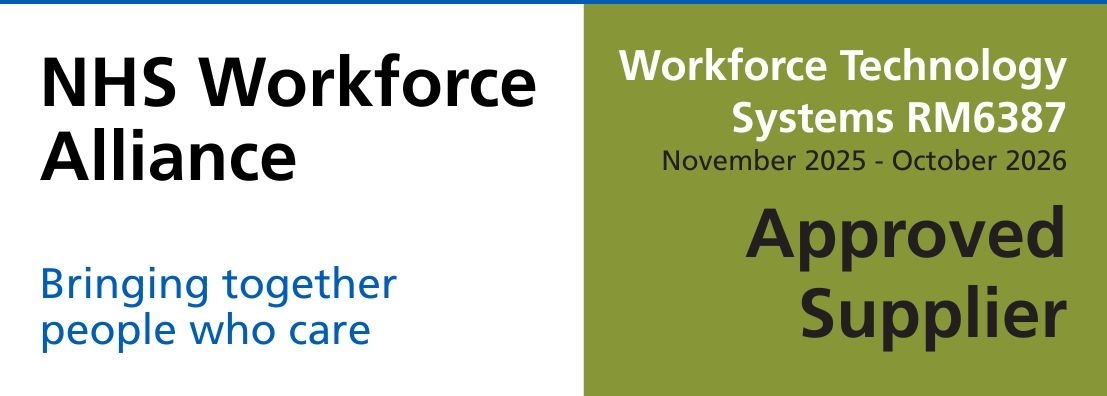
Blog by Flexzo
How Agency Dependence Is Harming NHS Trust Budgets
Ask any finance director or chief nurse in an NHS Trust about their biggest budget challenges, and agency spending will invariably feature near the top of their list.
While temporary staffing plays an essential role in maintaining safe care levels, the growing dependence on agencies is creating financial strain that affects the entire healthcare system in ways that many organisations are only beginning to fully understand.
The impact extends far beyond simple staffing costs and threatens the financial sustainability of Trusts across the UK.
Key Takeaways
- Hidden costs: Agency spending creates substantial hidden costs beyond hourly rates, including administrative burden, compliance complexity, and reduced efficiency.
- Financial impact: Every pound spent on agency premiums means less funding for equipment, facilities, patient care initiatives, and staff development.
- Vicious cycle: Agency dependence creates a self-reinforcing cycle that undermines recruitment, staff morale, and financial planning.
- Strategic solutions: Forward-thinking Trusts are breaking the cycle through strategic workforce planning, flexible permanent roles, and collaborative approaches.
- Technology’s role: New platforms like Flexzo Ai are helping Trusts reduce agency dependence through collaborative staff banks and AI-powered matching.
The True Cost Beyond the Invoice
When discussing agency spending, the conversation often focuses solely on the hourly rates paid to temporary staff.
This narrow view misses the deeper financial impact that affects NHS Trusts in ways that aren’t immediately visible in standard financial reports.
Understanding these hidden costs is essential for addressing the full scope of the problem.
Premium Pricing
Agency premiums represent a significant drain on healthcare budgets:
- A band 5 nurse working through an agency typically costs 50-100% more than their permanently employed counterpart
- For medical locums, especially consultants in shortage specialties, this premium can be substantially higher
- These additional costs don’t simply strain budgets – they directly reduce funds available for other essential services
Every pound allocated to agency premiums becomes unavailable for new equipment, improved facilities, patient care initiatives, or preventative programmes.
Budget Unpredictability
Perhaps equally concerning is how agency dependence undermines effective financial planning.
Trusts might carefully set budget allocations at the start of the financial year, only to find themselves forced into unplanned agency spending due to unexpected staff shortages or seasonal pressures.
This uncertainty creates ripple effects throughout the organisation:
- Finance teams constantly adjusting plans
- Important investments potentially delayed
- Funds held in reserve for possible agency costs instead of being deployed effectively
The Financial Domino Effect
When Trusts exceed their agency budgets, the financial impact cascades throughout the organisation in ways that affect both immediate operations and long-term development. This domino effect touches virtually every aspect of healthcare provision.
Delayed Capital Projects
Capital projects often face delays as funds are diverted to cover urgent staffing costs. These delays don’t just postpone improvements – they can increase the eventual cost of these projects and extend the time patients and staff must work in suboptimal environments. Preventative programmes may be scaled back when budgets tighten, potentially leading to higher acute care costs later as conditions that could have been prevented or managed early progress to requiring more intensive intervention.
Training Sacrifices
Training and development budgets frequently become casualties of agency overspending. This creates a particularly troubling dynamic where the very investments that could help address staffing shortages in the long term are sacrificed to manage those same shortages in the short term. Financial penalties for breaching agency caps add yet another layer of cost for Trusts already struggling with their budgets.
Budget Trade-offs
For every £1 million in unexpected agency spending, difficult decisions must be made about which other services or investments will be sacrificed. These trade-offs represent real impacts on patient care and staff working conditions that extend far beyond simple financial considerations.
Hidden Costs Compounding the Problem
Beyond the direct financial impact, agency dependence creates several hidden costs that compound the problem and make it increasingly difficult to break the cycle of dependency. These less visible costs often escape standard financial analysis but contribute significantly to the overall burden.
Administrative Burden
The administrative overhead associated with managing agency staffing is substantial. Processing each agency placement requires significant work:
- Checking credentials
- Managing timesheets
- Reconciling invoices
- Handling compliance documentation
A medium-sized Trust might have several staff members dedicated almost entirely to managing agency bookings and paperwork. These are resources that could otherwise support patient care or service improvement initiatives.
Compliance Complexity
Compliance management becomes increasingly complex with high agency use. Each agency worker needs their qualifications, DBS status, and professional registrations verified – a process often duplicated across different departments and agencies. If this process falters, Trusts face both clinical risks and potential regulatory issues, which can lead to additional costs. The challenge multiplies when using multiple agencies, each with their own compliance processes and standards.
Efficiency Losses
Productivity gaps represent another hidden cost. Agency staff, despite their clinical skills, typically lack familiarity with local systems and processes.
This learning curve reduces efficiency, especially during initial shifts in a new environment.
For patients with long-term or complex needs, the lack of continuity can impact care quality, potentially leading to:
- Longer hospital stays
- Higher readmission rates
- Increased care complexity
- Additional costs far beyond the direct staffing expenses
The Vicious Cycle Trapping Trusts
One of the most concerning aspects of agency dependence is how easily it becomes a self-reinforcing cycle that grows increasingly difficult to break. This vicious cycle affects recruitment, retention, and long-term financial health.
Recruitment Challenges
High agency spending can signal to potential permanent employees that a Trust is struggling with staffing issues, making recruitment even more challenging. Meanwhile, the attractive rates and flexibility offered by agencies draw potential permanent staff toward temporary work. This creates a cycle where Trusts struggle to fill permanent positions, leading to increased agency use, which in turn makes permanent recruitment more difficult.
Staff Morale Issues
Staff morale and retention suffer when permanent employees see agency colleagues earning significantly more for similar work. This discrepancy is particularly damaging when permanent staff find themselves regularly training or supporting temporary colleagues who receive higher compensation. Each permanent staff member who leaves for agency work represents both a loss of institutional knowledge and an almost certain increase in future staffing costs.
Dependency Entrenchment
What begins as a short-term solution to unexpected staffing gaps gradually becomes the default approach. As dependence grows, it becomes increasingly difficult to break the cycle, with agency spending becoming embedded in operational budgets rather than treated as an exceptional expense. Some departments find themselves with “permanent temporary” staff – agency workers filling the same role for months or even years, at significantly higher cost than a permanent appointment would require.
Breaking the Dependence Cycle
While agency staffing will always have a place in healthcare workforce planning, reducing unhealthy dependence requires a strategic, multi-faceted approach. Forward-thinking Trusts are exploring several pathways to more sustainable staffing models.
Strategic Workforce Planning
Effective long-term workforce planning helps anticipate and address potential gaps before they require agency solutions. This includes succession planning for key roles, strategic recruitment campaigns, and training pipelines aligned with future needs. Trusts taking a proactive rather than reactive approach to staffing generally experience lower agency spending over time, even when the initial investment in planning resources is substantial.
Flexible Permanent Roles
Many healthcare professionals choose agency work primarily for the flexibility it offers. Finding ways to build similar flexibility into substantive roles can help attract and retain permanent staff. Internal banks, self-rostering systems, and annualised hours contracts are approaches some Trusts are using to offer flexibility while maintaining the benefits of a permanent workforce.
Collaborative Approaches
Individual Trusts often find themselves competing for the same pool of temporary staff, driving up costs for everyone. Collaborative models like shared staff banks allow Trusts to work together rather than against each other. This approach provides the flexibility staff want without the agency premiums, while centralising compliance management to reduce administrative burden. Collaborative arrangements also make it easier to implement consistent rate cards across organisations, preventing the competitive escalation that drives up costs for all participants.
Technology-Enabled Staffing Solutions
Smart use of technology can dramatically reduce both the cost and administrative burden of flexible staffing. AI-powered matching systems connect available staff with shifts based on their skills, location, and preferences, making it easier to fill gaps without agency involvement. These systems provide valuable data to inform workforce planning, helping Trusts identify patterns in staffing needs and address underlying causes rather than symptoms.
Integrated Platforms
Platforms like Flexzo demonstrate how technology can facilitate collaborative approaches, connecting healthcare professionals directly with multiple NHS organisations through an integrated staff bank. This model eliminates costly intermediaries while maintaining the flexibility that both organisations and staff need. It also addresses many of the hidden costs associated with agency use, from compliance management to administrative overhead.
Streamlined Compliance
Automated compliance tracking represents another significant technological advancement. By creating portable credentials that follow healthcare professionals across different facilities, these systems eliminate the duplication of verification processes while maintaining rigorous standards. This not only reduces administrative costs but also removes barriers that prevent qualified staff from working where they’re needed most.
A Balanced Approach
No single solution will completely eliminate the need for agency staff, nor should that be the goal. Temporary staffing provides essential flexibility in a system where demand can fluctuate significantly and unexpectedly.
The aim should be a balanced approach where agency use becomes:
- Strategic rather than reactive
- A deliberate choice in specific circumstances
- Not the default response to systemic staffing challenges
Shift in Perspective
By combining better workforce planning, innovative flexible working models, collaborative approaches between organisations, and smart technology, NHS Trusts can reduce their agency dependence to healthier, more sustainable levels. This isn’t just about saving money, although the potential savings are substantial. It’s about creating a more resilient healthcare system where budgets focus on patient care rather than unnecessary premiums and administrative costs.
Forward-thinking NHS leaders recognise that addressing agency dependence requires a fundamental shift in how we approach workforce planning and management. Rather than treating staffing as an operational issue to be handled day by day, these leaders view it as a strategic priority requiring sustained attention and investment. This perspective shift opens the door to more innovative and effective approaches that can break the cycle of dependence.
Collaborative Staff Bank Approach
The challenges of agency dependence require new thinking and fresh approaches. Collaborative staff banks offer a practical example of how technology is reshaping healthcare staffing. By directly connecting NHS Trusts with healthcare professionals through a shared platform, this model eliminates the middleman costs while maintaining the flexibility that both organisations and staff need.
Get in Touch
To understand how new staffing models might work in your organisation’s specific context, exploring the available options is worthwhile.
What Flexzo Ai can offer your Trust:
- Reduced agency dependence
- A more sustainable approach to flexible staffing
- Expertise from professionals with NHS recruitment experience
- Proven solutions working with NHS organisations across the UK
Please get in touch to learn more about how we’re helping NHS Trusts like yours address agency dependence challenges.






